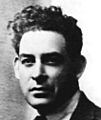José Sabogal facts for kids
José Sabogal (born March 19, 1888, in Cajabamba, Peru – died December 15, 1956, in Lima) was a very important Peruvian painter and muralist. He was known as a leader in the "indigenist" art movement in Peru. This movement focused on celebrating and showing the culture of Peru's native people. For about 30 years, Sabogal was a strong supporter of this style of art.
Contents
About José Sabogal
José Sabogal was born in Cajabamba, a town in the Cajamarca area of Peru. When he was young, from 1908 to 1913, he traveled a lot in Europe, especially in Italy, and also in North Africa. After his travels, he went to the National School of Fine Arts in Buenos Aires, Argentina. He studied art there for five years.
In 1922, José Sabogal married María Wiesse, who was a poet and writer. They had two children together: José Rodolfo and Rosa Teresa.
Sabogal started teaching at the Escuela Nacional de Bellas Artes, Lima (National School of Fine Arts in Lima) in 1920. Later, he became the director of the school, leading it from 1932 to 1943. After that, he helped start the Instituto Libre de Arte Peruano (Free Institute of Peruvian Arts). This institute was part of the Museo Nacional de la Cultura Peruana (National Museum of Peruvian Culture).
His granddaughter, Isabel Sabogal, is also a writer. She writes novels and poems in both Spanish and Polish.
What is Indigenism in Art?
Even though José Sabogal's family came from Spain, he strongly supported and showed off the ancient cultures of Peru. These were the cultures that existed before the Spanish arrived. This artistic style is called "indigenism."
Sabogal became very interested in indigenism after spending six months in Cuzco. He loved painting the city and its people. In 1919, his paintings from Cuzco were shown in an exhibition in Lima. People were very impressed by his work. This exhibition was a big moment for Peruvian art.
In 1922, Sabogal visited Mexico. There, he met famous Mexican muralists like Diego Rivera, José Clemente Orozco, and David Alfaro Siqueiros. After this trip, Sabogal decided to help show Peruvian art to people all over the world. He was very successful! In the 1920s, José Sabogal became the most important artist in Peru. He started and led the "Peruvian School" of painting for many years.
José Sabogal's Writings
Besides being a painter, José Sabogal also wrote several books. His books were often about Peruvian art and culture. Some of his works include:
- Mates burilados: Arte vernacular peruano (1945) - This book was about carved gourds, a type of Peruvian folk art.
- Pancho Fierro, estampas del pintor peruano (1945) - This book was about another Peruvian painter named Pancho Fierro.
- El toro en las artes populares del Perú (The bull in the Peruvian popular arts) (1949)
- El "kero", vaso de libaciones cusqueño de madera pintada (1952) - This book was about "keros," which are special painted wooden cups from Cuzco.
- El desván de la imaginería peruana (1956, 1988)
- Del arte en el Perú y otros ensayos (About Peruvian art and other essays) (1975)
Images for kids
See also
 In Spanish: José Sabogal para niños
In Spanish: José Sabogal para niños


